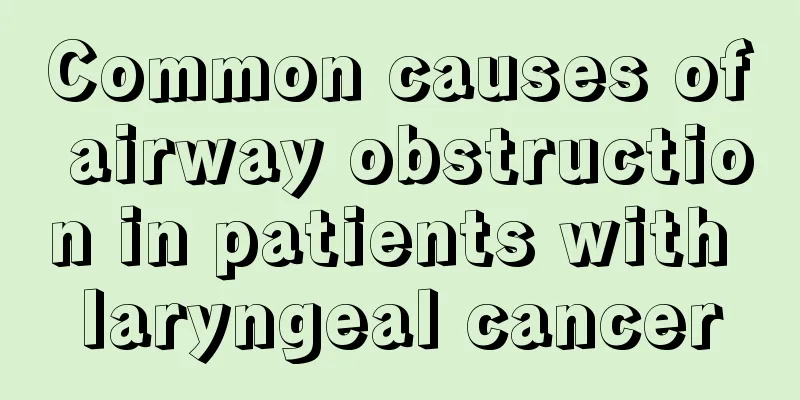What are the treatments for bile duct cancer? Experts point out 5 steps to prevent and treat liver cancer

|
5 Steps to Liver Cancer Prevention and Treatment Liver cancer is not something to be feared. As long as it is properly prevented and treated, you can stay away from the harm of liver cancer. The prevention and treatment of liver cancer can be divided into 5 steps. 1 is 1 basic concept Liver cancer mainly occurs in relatively specific groups of people, which are often referred to as high-risk groups in clinical practice. The high-risk groups for liver cancer in my country mainly include patients with hepatitis B and hepatitis C, patients with cirrhosis, men over 40 years old, or people with a family history of liver cancer. Patients with cirrhosis caused by non-viral hepatitis are also at high risk of liver cancer, but the risk is much lower than that of viral hepatitis. These people should pay special attention to the prevention of liver cancer. 2 means two central concepts People at high risk of liver cancer should establish two concepts, namely active prevention and early diagnosis. Actively treat basic liver diseases such as viral hepatitis to prevent or alleviate the progression of liver fibrosis to the greatest extent; stay away from environmental factors such as water pollution and spoiled food; maintain a healthy mental state and other measures to help prevent liver cancer. Early diagnosis is the key to improving the efficacy of liver cancer treatment. 3 means 3 screening items Liver function, alpha-fetoprotein and liver ultrasound are scientific and effective ways to screen people at high risk of liver cancer. Generally speaking, people at high risk of liver cancer should be screened every 3 to 6 months. When alpha-fetoprotein is elevated or ultrasound indicates liver space-occupying lesions, further examinations such as CT, MRI or arteriography should be performed until liver cancer is completely ruled out. 4 means 4 major treatment measures Treatment measures for liver cancer include four major categories, namely surgical treatment, local treatment, interventional embolization therapy, and drug therapy. 5 means 5-year survival goal As long as people at high risk of liver cancer have a clear self-positioning and are able to "tirelessly" undergo regular screening, early diagnosis of liver cancer will no longer be difficult, and it will no longer be difficult for liver cancer patients to achieve a five-year survival period. What are the treatments for cholangiocarcinoma? Intrahepatic cholangiocarcinoma is a clinical pathological type of primary liver cancer, accounting for about 5% to 30% of primary liver cancer. Intrahepatic cholangiocarcinoma has a low incidence, lacks specific clinical manifestations in the early stage, has a low diagnosis rate, is insensitive to radiotherapy and chemotherapy, and therefore has a poor prognosis. The specific contents of the prognostic factors analysis and treatment of intrahepatic cholangiocarcinoma are as follows: Surgery Some scholars have found that hepatitis B virus infection is closely related to the incidence of primary intrahepatic cholangiocarcinoma, and some causes of hepatitis B virus may play an important role in the mutation of cholangiocarcinoma. At the same time, most clinical studies have shown that radical resection is the main treatment for long-term survival of intrahepatic cholangiocarcinoma. In a group of correlation studies, the survival of 56 surgical patients who underwent radical resection was 36 months, and that of palliative resection was 10 months. Multivariate survival regression analysis showed that the surgical method was an independent prognostic factor, with a relative risk RR=0.175, indicating that radical surgery is a protective factor. Therefore, all intrahepatic cholangiocarcinomas should be judged by experienced hepatobiliary surgeons as much as possible to avoid missing the opportunity for radical surgery. Experts pointed out that although intrahepatic cholangiocarcinoma is often accompanied by elevated serum alanine aminotransferase and aspartate aminotransferase, both are non-specific because their serum levels are elevated in many diseases such as hepatitis, cirrhosis and hepatocellular carcinoma. Nonsurgical treatment Experts point out that the median survival time of non-surgical patients is only 9 months, which may be related to the fact that most patients already have intrahepatic or extrahepatic metastases at the time of diagnosis. For patients with intrahepatic cholangiocarcinoma who cannot undergo surgery, the incidence of jaundice is lower than that of hilar and extrahepatic cholangiocarcinoma due to the location of the tumor. Therefore, the commonly used palliative treatment methods are mainly chemotherapy, local radiotherapy and autologous immune cell therapy. For obstructive jaundice caused by large tumors, biliary stent implantation or percutaneous liver puncture and external biliary drainage can also be used. In general, chemotherapy has a low efficacy for intrahepatic cholangiocarcinoma. Chemotherapy regimens mostly use 5-FU alone or combined chemotherapy regimens based on 5-FU. However, due to the toxic side effects of chemotherapy drugs, they will have great toxic and side effects on the human body. Therefore, for patients who cannot undergo surgery, palliative chemotherapy has a low effective survival rate for patients, which will also affect the prognosis of intrahepatic cholangiocarcinoma. . Therefore, it is often recommended to combine autologous immune cell therapy in clinical practice to improve the patient's autonomous anti-tumor immunity, improve the patient's overall physical condition, increase the local control rate of tumors, and improve prognosis. How should intrahepatic cholangiocarcinoma be treated? What method has the best treatment effect? |
<<: What causes cancer patients to die? What are the symptoms that can relieve lung cancer patients?
Recommend
What are the characteristics of adolescent ovarian tumors
What are the characteristics of adolescent ovaria...
Why do I still have cramps after taking calcium supplements
Calcium supplementation should be multi-pronged A...
What to do if hydronephrosis is caused by kidney stones
Kidney stones may also cause hydronephrosis, so o...
The TV is too high and the couple suffers from cervical spondylosis
Eating from the same pot and sleeping in the same...
Nursing measures for bladder cancer
Nursing measures for bladder cancer? Bladder canc...
What is the reason for the white spots on my arms
The phenomenon of white spots on the body must be...
What should you pay attention to in your diet before rectal cancer surgery
There is a relatively strict intestinal preparati...
Why is my left fist so weak?
People's advantageous parts are arms, because...
What dishes can you make with fried dough sticks
Many people in our daily life like to eat fried d...
What to do if the legs are hot due to lumbar spine
The lumbar spine can cause some complications, so...
What to do if you get nervous and blush easily
Blushing due to nervousness is mainly due to pers...
Can I eat bamboo shoots if I have skin allergies
Bamboo shoots are a type of vegetable food and ar...
What to do if you have a sore throat due to inflammation
Getting a sore throat due to heat is a very commo...
What is the reason for the blackening of fingernails? It turns out this is what caused it
The phenomenon of black fingernails must be cause...
Will brain cancer cause amnesia and convulsions?
Late stage brain tumors can lead to space-occupyi...









